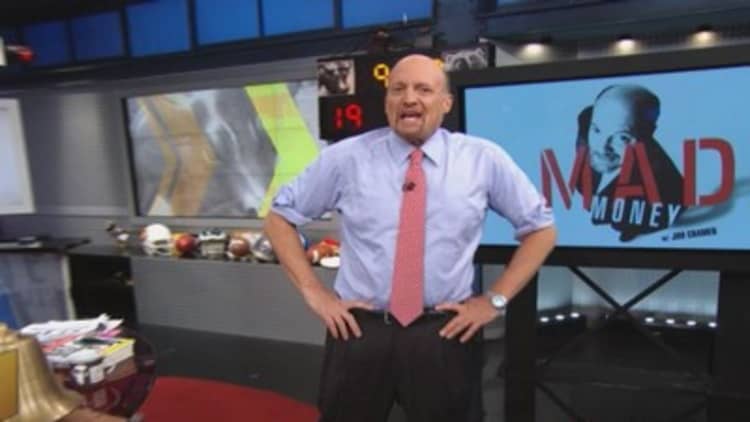
There's been a lot of talk about the death cross emerging in the charts of the Russell 2000. However, you probably haven't heard about this.
There are some technical analysts who believe the pattern may be bullish over the long-term. That's right - bullish.
Bob Lang, the founder and senior strategist at ExplosiveOptions.net is one of them. Jim Cramer was so intrigued he turned to Lang for details.
If you follow technicals, you may already know that a death cross can present itself in any chart. It's simply a pattern in which the short-term 50-day moving average crosses below the longer-term 200-day moving average.
Typically the pattern is worrisome because it suggests a stock's near-term trajectory has grown worse than its long-term trajectory. According to conventional wisdom, that's no good.
However, Lang says in the case of the Russell 2000, an index of small cap stocks, conventional wisdom does not apply. In fact, conventional wisdom has it backwards.
Using information compiled by Ryan Detrick from SeeItMarket.com, Lang says that since December of 1988, there have been 19 death crosses in the Russell 2000.
And, yes, they were bearish in the very near-term. Initially, the Russell 2000 tumbled, selling off an average of 1.92 percent in the first five days after the death cross.
However, on average the losses quickly began to reverse.
According to the research, ten days later, the Russell 2000 was only down an average of 0.7 percent. Three months later, the Russell 2000 had gained an average gain of 1.57 percent.
Believe it or not, from there, the historical patterns actually turn very bullish.
Six months after a death cross, the Russell 2000 had rallied, on average, 7.54 percent, and a year later it posted an average gain of nearly 12 percent.
And if you really want to get wonky, the median figures for the index's last 19 death crosses are even more positive, with the median example giving you a 4 percent gain after three months, an 11.8 percent gain after six months, and a 17.4 percent gain after 12 months.
In other words, although the pattern may appear bearish and the name of the pattern may trigger fear, according to Lang's research, the death cross, on average, isn't negative.
In fact, Lang says if you got carried away by the rhetoric and sold the Russell 2000 on every death cross since 1988 and only bought it back after the death cross reversed itself with a so-called golden cross, where the 50-day moving average crosses above the 200-day, then on average you'd have a 5.5 percent loss.
-----------------------------------------------------------
Read more from Mad Money with Jim Cramer
Hedge funds roiling your profits
Don't hold your breath waiting for more LBOs
Cramer: 20% gain ahead in this stock
-----------------------------------------------------------
Given the technical analysis, and Cramer's belief that the US economy is a bastion of relative strength, Cramer thinks taking a bearish position in the small cap index made up of mostly domestically focused companies, is, at best, misguided.
"The charts, as interpreted by Bob Lang, and the empirical data provided by Ryan Detrick, suggest a death cross in the Russell 2000 won't hurt bulls. Despite the name, it may actually be a buy signal for small caps," Cramer said.
Call Cramer: 1-800-743-CNBC
Questions for Cramer? madmoney@cnbc.com
Questions, comments, suggestions for the "Mad Money" website? madcap@cnbc.com



